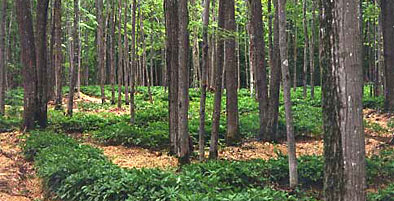Long leaf pine needles are the most prized when it comes to weaving pine needle baskets. The long leaf pine tree is typically found in the Southeast from the east coast of North Carolina to the Florida’s Gulf coast. The long leaf pine needles last longer in the weaving process than shorter needles do and are therefore used more often in basketry. Nancy Basket is a Cherokee descendant and is renowned for her pine needle baskets and kudzu installations. In this series, she explains the process of collecting, drying, and weaving pine needles into baskets.
Pine needles can be collected green from live trees or when they’re already brown from fallen trees. The long leaf pine needles are longest when they’re at the young, grassy stage. Young needles will fall anyway and can be collected in moderation without harming the tree. If collecting pine needles from private property, permission should be obtained prior to gathering needles. Dead pine trees may be found near roadsides for collection. Needles can be collected from these sources and are preferably gathered when they are still attached to the branches. Buying pine needles in bales typically sold for yard mulch is not advised as they are often broken and will be in poor shape for basket weaving. Needles that have been on the ground for too long may be wet and will mold if not dried properly.
Pine needles can not be woven while green. They shrink while drying and the raffia palm or nylon thread used to weave them together will become loose. Once green needles are collected, they should be spread on a screen and dried in the sun. It’s best to turn the needles in order to obtain the same rich, sun-baked brown on all sides of the needle. Alternatively, needles can be dried indoors for a slight mint green color. Green needles should not be kept clumped together or in damp conditions as they will quickly rot.
Owner of Kudzu Kabin Designs, Nancy Basket, explains the legality behind adding found objects such as migratory bird feathers to pine needle baskets. (See Migratory Bird Treaty Act) Caution should be used if incorporating objects such as bear claws, antlers, turtle shells, and other animal parts into baskets as the laws vary in each state and a traveling art vendor could be penalized if found with such objects, even if it is legal in their home state. Incorporating designs made with stone or pottery is legal and can add to the artistry of a pine needle basket.
A pine needle basket can be sewn using raffia, a type of palm native to the tropical regions of Africa. While the raffia is in keeping with the natural ‘feel’ of the pine needle basket, synthetic fibers can also be used just as easily. The roots of the raffia are threaded through a large needle. The end of the raffia is held in line with a group of 7 longleaf pine needles at the sheath end. Raffia is then wrapped around the sheaths several times and the needle then comes up at the end of the wrapped section to make the first stitch. Nancy Basket demonstrates the construction of a pine needle basket in this video. She explains the spacing of the stitches, the term “feeding the tail”, and the way to end a piece of raffia and begin a new piece.
